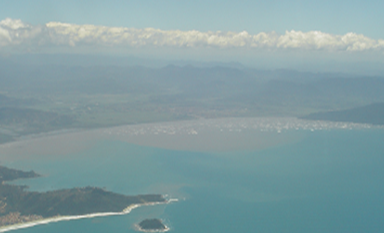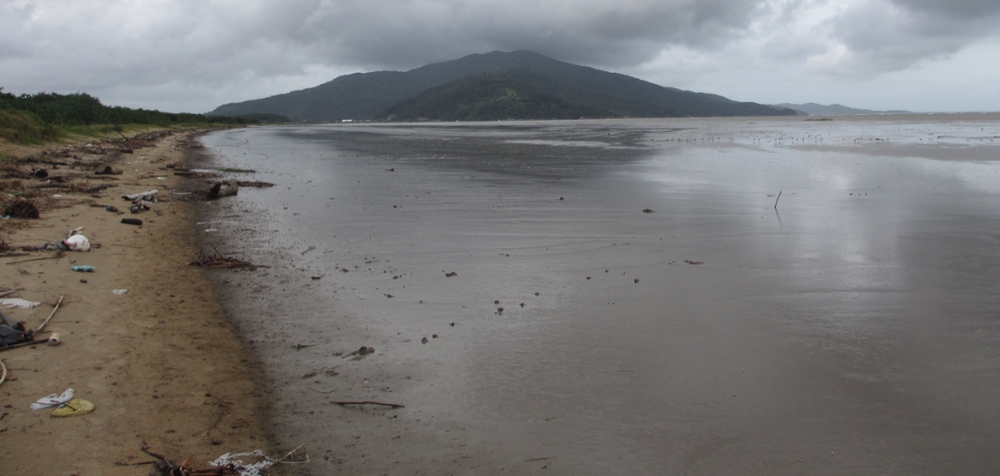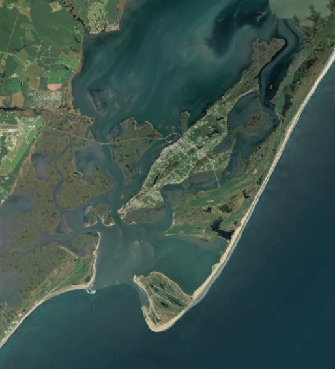Progradational Beaches as Archives of Holocene Coastal Change
 |
|
Understanding past coastal responses to climate and sea-level change at local and regional scales is crucial to our ability to predict future climate-change impacts on these systems over decadal to centennial timescales. Progradational beach-ridge plains are found worldwide and have the potential to record minor variability in sea level, sediment supply, and storminess, thus providing just this insight into past coastal behavior. We are studying the stratigraphy, morphology, and processes responsible for the development of such progradational systems, and using them to develop records of past changes in sea level, regional hydroclimate, wave climate, and sediment fluxes. |
Current Studies |
Coastal response to climate dynamics: Tijucas & Pinheira Strandplains, Brazil Overview: Strandplains formed in regimes of abundant sediment supply and sea-level fall have the potential to record changes in the volumes and nature (type) of sediment delivered to them during the period of formation, as well as the hydrodynamic processes responsible for their formation. This study uses the Tijucas and Pinheira strandplains in southern Brazil as >5000-year-long archives of fluvial sediment delivery and wave reworking along the coast to investigate the nature of upland and coastal response to Holocene climate change. Studies use geomorphic, geophysical, sedimentological, and geochemical analyses, as well as hydrodynamic modeling. Overview: Strandplains formed in regimes of abundant sediment supply and sea-level fall have the potential to record changes in the volumes and nature (type) of sediment delivered to them during the period of formation, as well as the hydrodynamic processes responsible for their formation. This study uses the Tijucas and Pinheira strandplains in southern Brazil as >5000-year-long archives of fluvial sediment delivery and wave reworking along the coast to investigate the nature of upland and coastal response to Holocene climate change. Studies use geomorphic, geophysical, sedimentological, and geochemical analyses, as well as hydrodynamic modeling. Collaborators: Julie Krask (USC), Valier Galy (WHOI), Duncan FitzGerald (Boston University), Antonio Klein (Federal University of Santa Catarina)
|
Chenier Formation: Tijucas Strandplain, Brazil Overview: Cheniers are sandy or shelly beach ridges separated by intervening mud-flat deposits with marsh and swamp vegetation. In addition to its broad transitions between periods of sand amd mud deposition, the Tijucas Strandplain contains at least four chenier complexes consisting of closely spaced (25–40 m apart) 50–75 m wide ridges composed of 3–4 m thick shelly sand underlain and separated by a cohesive basin-fill clay; a future chenier is forming 1 km offshore where breaking waves concentrate sand. We are mapping this set of cheniers using ground-penetrating radar, sediment cores, and (in the case of the modern offshore chenier) hydrodynamic process data, with the goal of better understanding the processes and controls on chenier formation. Overview: Cheniers are sandy or shelly beach ridges separated by intervening mud-flat deposits with marsh and swamp vegetation. In addition to its broad transitions between periods of sand amd mud deposition, the Tijucas Strandplain contains at least four chenier complexes consisting of closely spaced (25–40 m apart) 50–75 m wide ridges composed of 3–4 m thick shelly sand underlain and separated by a cohesive basin-fill clay; a future chenier is forming 1 km offshore where breaking waves concentrate sand. We are mapping this set of cheniers using ground-penetrating radar, sediment cores, and (in the case of the modern offshore chenier) hydrodynamic process data, with the goal of better understanding the processes and controls on chenier formation.Collaborators: Alice Staro (Boston University), Duncan FitzGerald (Boston University), Ioannis Georgiou (Water Institute of the Gulf)
|
Inlet-associated beach- and fordune-ridge growth: The Chincoteague-Assateague-Wallops Island System, Virginia Overview: This study addresses interactions between updrift coastal landforms and downdrift coastal behavior, by quantifying the volume and fluxes of sediment trapped in the Assateague-Chincoteague-Wallops barrier-island complex along the Virginia coast and relating these to downdrift coastal-system behavior. We have found that historical sand fluxes to the elongating spit on southern Assateague Island and progradational beach ridges on northernmost Wallops Islands are equivalent to at least 60% of estimated regional longshore transport rates, demonstrating that sediment trapping and associated wave refraction are the primary drivers of downdrift barrier erosion. Ongoing work explores the internal structure of the associated beach ridges on the three islands, and relates that to time-varying changes in wave energy, through coupling with hydrodynamic / sediment-transport models of Chincoteague Inlet and viscinity. Overview: This study addresses interactions between updrift coastal landforms and downdrift coastal behavior, by quantifying the volume and fluxes of sediment trapped in the Assateague-Chincoteague-Wallops barrier-island complex along the Virginia coast and relating these to downdrift coastal-system behavior. We have found that historical sand fluxes to the elongating spit on southern Assateague Island and progradational beach ridges on northernmost Wallops Islands are equivalent to at least 60% of estimated regional longshore transport rates, demonstrating that sediment trapping and associated wave refraction are the primary drivers of downdrift barrier erosion. Ongoing work explores the internal structure of the associated beach ridges on the three islands, and relates that to time-varying changes in wave energy, through coupling with hydrodynamic / sediment-transport models of Chincoteague Inlet and viscinity.Collaborators: Justin Shawler (USACE-ERDC), Ioannis Georgiou (Water Institute of the Gulf), Michael Fenster (Randolph-Macon College), Mohiuddin Sakib (University of New Orleans)
Funding: Commonwealth of Virginia
Click here to download PDF for information about Measuring Overwash (MeOw) sensor equipment stationed on Assateague Island in October 2025.
|
|
|
Beach ridges as recorders of sea-level fall: SvalbardOverview: In regions covered with ice sheets during the last glacial period sea level has continued to fall for thousands of years as the deglaciated land has isostatically rebounded. We are using the tools of sedimentology, stratigraphy, and geochronology to study those past changes in sea-level and the associated evolution of coarse-grained (pebbles to boulders) beach-ridge plains in the far north coastal systems of Svalbard, with the goal of better understanding what these beach-ridge systems can tell us about coastal change and sensitivites to environmental change. Reindeer and polar bears abound in this region of endless sun (at least the time of year we are there), but, very unlike the barrier islands of the Mid-Atlantic, there are NO bugs.
Collaborators: Matt Strzelecki (University of Wroclaw), Sebastian Lindhorst (University of Hamburg)
 |
PublicationsPlease feel free to contact us for pdf copies of any of the following publications. Note: * - Coastal Geology Lab student author *Shawler, J.L., Hein, C.J., Sakib, M.M., Messina, F., Georgiou, I.Y., 2025. Local versus regional controls on the morphology and texture of preserved beach and foredune ridges, Journal of Geophysical Research: Earth Surface. v. 130, p. e2025JF008429 doi: 10.1029/2025JF008429 *Shawler, J.L., Hein, C.J., *Obara, C.A., *Robbins, M.G., Huot, S., Fenster, M.S., 2021. The effect of coastal landform development on decadal-to millennial-scale longshore sediment fluxes: Evidence from the Holocene evolution of the central mid-Atlantic coast, USA. Quaternary Science Reviews, 267, p.107096. doi: 10.1016/j.quascirev.2021.107096 Hein, C.J., Ashton, A.D., 2020. Long-term shoreline morphodynamics: processes and preservation of environmental signals. Sandy Beach Morphodynamics, p.487-531. Silva, A.P., Klein, A.H.F., Fetter Filho, A.F.H., Hein, C.J., Mendez, F.J., Broggio, M.F., Dalinghaus, C., 2020. Climate-induced variability in South Atlantic wave direction over the past three millennia, Scientific Reports, v. 10, 18553, doi: 10.1038/s41598-020-75265-5. Billy, J., Robin, N., Hein, C.J., FitzGerald, D.M., Certain, R., 2018, Impact of relative sea-level changes since the last deglaciation on the formation of a composite paraglacial barrier, Marine Geology, v. 400, p. 76-93, doi:10.1016/j.margeo.2018.03.009. Billy, J., Robin, N., Hein, C.J., FitzGerald, D.M., Certain, R., 2018, Dominance of inherited geologic framework on the development of a coastal barrier system, Journal of Coastal Research, SI85, p. 406-410, doi:10.2112/SI85-082.1. Hein, C.J., FitzGerald, D.M., *de Souza, L.H.P., Georgiou, I.Y., Buynevich, I.V., Klein, A.H.F., de Menezes, J.T., Cleary, W.J., *Scolaro, T., 2016, Complex coastal change in response to autogenic basin infilling: An example from a sub-tropical Holocene strandplain, Sedimentology, v. 63, no. 6, p. 1362-1395, doi: 10.1111/sed.12265. Billy, J., Robin, N., Hein, C.J., Certain, R., FitzGerald, D.M., 2015, Insight into the Late Holocene sea-level changes in the NW Atlantic from a Paraglacial Beach-Ridge Plain South of Newfoundland, Geomorphology, v. 248, p. 134-146. Hein, C.J., Georgiou, I.Y., FitzGerald, D.M., *de Souza, L.H.P., Klein, A.H.F., de Menezes, J.T, 2015. Wave energy, sediment supply, and sea-level fall: Late Holocene basin infilling in southern Brazil, In: Coastal Sediments ’15, Proceedings of the 11th International Symposium on Coastal Engineering and Science of Coastal Sediment Processes. Hein, C.J., FitzGerald, D.M., Cleary, W.J., Klein, A.H.F., de Menezes, J.T., *Albernaz, M.B., 2014, Coastal response to late-stage transgression and sea-level highstand, Geological Society of America Bulletin, v. 126, no. 3/4, p. 459-480, doi: 10.1130/B30836.1. Billy, J., Robin, N., Hein, C.J., Certain, R., FitzGerald, D.M., 2014, Internal architecture of mixed sand-and-gravel beach ridges: Miquelon-Langlade Barrier, NW Atlantic, Marine Geology, v. 357, p. 53-71, doi: 10.1016/j.margeo.2014.07.011. Hein, C.J., FitzGerald, D.M., Cleary, W.J., Albernaz, M.B., de Menezes, J.T., Klein, A.H.F., 2013, Evidence for a transgressive barrier within a regressive strandplain system: Implications for complex coastal response to environmental change, Sedimentology, v. 60, p. 469-502. Billy, J., Robin, N., Certain, R., Hein, C.J., Berné, S., 2013, Barrier shoreline evolution constrained by shoreface sediment reservoir and substrate control: The Miquelon-Langlade Barrier, NW Atlantic, Journal of Coastal Research, SI 65, p. 2089-2094. Hein, C.J., FitzGerald, D.M., Milne, G.A., Bard, K.A., and Fattovich, R., 2011, Evolution of a Pharaonic harbor on the Red Sea: Implications for coastal response to changes in sea level and climate, Geology, v. 39, no. 7, p. 687-690. Buynevich, I.V., Klein, A. H. F., FitzGerald, D.M., Cleary, W.J., Hein, C.J., Veiga, F.A., Angulo, R.J., Asp, N.E., Petermann, R., 2011, Geological legacy of storm erosion along a high-energy indented coastline: northern Santa Catarina, Brazil, Journal of Coastal Research, SI 64, p. 1840-1844. FitzGerald, D.M., Cleary, W.J., Buynevich, I.V., Hein, C.J., Klein, A.H.F., Asp, N., Angulo, R, 2007. Strandplain evolution along the southern coast of Santa Catarina, Brazil, Journal of Coastal Research, SI 50, p. 152-156. |
Recent Abstracts & PresentationsFeel free to contact us for pdf copies of any of the following abstracts or their associated presentations or posters. Note: * - student author Billy, J., Robin, N., Hein, C.J., Certain, R., FitzGerald, D.M., 2018, Primary influence of inherited geologic framework on the development of a coastal barrier system. International Coastal Symposium 2018, Busan, Republic of Korea, May 2018. *Krask, J., Hein, C.J., Galy, V.V., FitzGerald, D.M., Klein, A.H.d.F., 2017, Beach-ridge sedimentology as an archive of terrestrial climate change: Insights from a geochemical and stratigraphic study of the Tijucas Strandplain, southern Brazil, AGU Fall Meeting, New Orleans, LA, December 2017. Billy, J., Hein, C.J., Robin, N., Certain, R., FitzGerald, D., 2017, Beach-ridge internal architecture and use for Holocene sea-level reconstruction: A case study from the Miquelon-Langlade Isthmus (NW Atlantic), AGU Fall Meeting, New Orleans, LA, December 2017. FitzGerald, D.M., Hein, C.J., Georgiou, I., Klein, A.H.d.F., 2017, Chenier development within a prograding strandplain complex, AGU Fall Meeting, New Orleans, LA, December 2017. Strzelecki, M., Lindhorst, S., Hein, C.J., *Raff, J. 2016, Holocene deglaciation, sea-level changes and shifts in sediment supply recorded in High Arctic paraglacial coastal systems – Bjonapynten case study, Tempelfjorden, Central Spitsbergen, XI International Conference on Permafrost, Potsdam, Germany, June 2016. Hein, C.J., Georgiou, I.Y., FitzGerald, D.M., *de Souza, L.H.P., 2015, Wave energy, sediment supply and sea-level fall: Late Holocene basin infilling in southern Brazil, Coastal Sediments ’15, San Diego, CA, May, 2015. |

